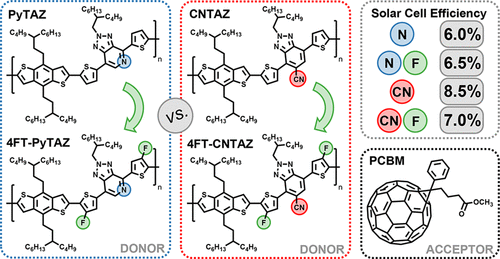当前位置:
X-MOL 学术
›
ACS Appl. Polym. Mater.
›
论文详情
Our official English website, www.x-mol.net, welcomes your feedback! (Note: you will need to create a separate account there.)
Functionalization of Benzotriazole-Based Conjugated Polymers for Solar Cells: Heteroatom vs Substituents
ACS Applied Polymer Materials ( IF 5 ) Pub Date : 2020-09-21 , DOI: 10.1021/acsapm.0c00761 Jeromy James Rech 1 , Liang Yan 1 , Zhen Wang 2 , Qianqian Zhang 1 , Spencer Bradshaw 1 , Harald Ade 2 , Wei You 1
ACS Applied Polymer Materials ( IF 5 ) Pub Date : 2020-09-21 , DOI: 10.1021/acsapm.0c00761 Jeromy James Rech 1 , Liang Yan 1 , Zhen Wang 2 , Qianqian Zhang 1 , Spencer Bradshaw 1 , Harald Ade 2 , Wei You 1
Affiliation

|
With the recent remarkable advances in the efficiency of organic solar cells, the need to distill key structure–property relationships for semiconducting materials cannot be understated. The fundamental design criteria based on these structure–property relationships will help realize low-cost, scalable, and high-efficiency materials. In this study, we systematically explore the impact of a variety of functional groups, including nitrogen heteroatoms, fluorine substituents, and cyano groups, on benzotriazole (TAZ)-based acceptor moieties that are incorporated into the conjugated polymers. Specifically, a pyridine heterocycle was used to replace the benzene unit of TAZ, leading to the PyTAZ polymer, and a cyano substituent was added to the benzene of the TAZ unit, resulting in the CNTAZ polymer. The PyTAZ polymer suffers from low mobility and poor exciton harvesting, driven by large and excessively pure domains when blended with PCBM. The inclusion of fluorine substituents, placed strategically along the polymer backbone, can mitigate these issues, as shown with 4FT–PyTAZ. However, when this same approach is used for the cyano-functionalized polymer (CNTAZ), the resulting polymer (4FT–CNTAZ) is overfunctionalized and suffers from impure domains and recombination issues. The cyano group has a larger impact on the TAZ core compared to the nitrogen heteroatom due to the strong electron-withdrawing strength of the cyano group. Because of this, further functionalization of the cyano-based polymers has less fruitful impact on the polymer properties and results in deterioration of the solar cell efficiency. Overall, this work highlights some of the benefits, thresholds, and limitations for functionalization of conjugated polymers for organic solar cells.
中文翻译:

苯并三唑基共轭聚合物对太阳能电池的功能化:杂原子与取代基
随着有机太阳能电池效率最近的显着进步,提炼半导体材料的关键结构与特性关系的需求不可低估。基于这些结构-属性关系的基本设计标准将有助于实现低成本,可扩展和高效的材料。在这项研究中,我们系统地探索了各种官能团,包括氮杂原子,氟取代基和氰基,对掺入共轭聚合物中的苯并三唑(TAZ)基受体部分的影响。具体地,使用吡啶杂环代替TAZ的苯单元,得到PyTAZ聚合物,并且将氰基取代基添加到TAZ单元的苯中,得到CNTAZ聚合物。当与PCBM混合时,PyTAZ聚合物的迁移率低且激子收割性能差,这是由于较大且过于纯净的区域所致。如4FT–PyTAZ所示,在聚合物主链上有策略地放置氟取代基可以减轻这些问题。但是,当将相同的方法用于氰基官能化聚合物(CNTAZ)时,所得聚合物(4FT–CNTAZ)官能化过度,并且存在不纯结构域和重组问题。与氰基杂原子相比,氰基对TAZ核的影响更大,这是因为氰基具有很强的吸电子强度。因此,氰基聚合物的进一步官能化对聚合物性能的影响较小,并导致太阳能电池效率下降。总体,
更新日期:2020-09-21
中文翻译:

苯并三唑基共轭聚合物对太阳能电池的功能化:杂原子与取代基
随着有机太阳能电池效率最近的显着进步,提炼半导体材料的关键结构与特性关系的需求不可低估。基于这些结构-属性关系的基本设计标准将有助于实现低成本,可扩展和高效的材料。在这项研究中,我们系统地探索了各种官能团,包括氮杂原子,氟取代基和氰基,对掺入共轭聚合物中的苯并三唑(TAZ)基受体部分的影响。具体地,使用吡啶杂环代替TAZ的苯单元,得到PyTAZ聚合物,并且将氰基取代基添加到TAZ单元的苯中,得到CNTAZ聚合物。当与PCBM混合时,PyTAZ聚合物的迁移率低且激子收割性能差,这是由于较大且过于纯净的区域所致。如4FT–PyTAZ所示,在聚合物主链上有策略地放置氟取代基可以减轻这些问题。但是,当将相同的方法用于氰基官能化聚合物(CNTAZ)时,所得聚合物(4FT–CNTAZ)官能化过度,并且存在不纯结构域和重组问题。与氰基杂原子相比,氰基对TAZ核的影响更大,这是因为氰基具有很强的吸电子强度。因此,氰基聚合物的进一步官能化对聚合物性能的影响较小,并导致太阳能电池效率下降。总体,


























 京公网安备 11010802027423号
京公网安备 11010802027423号